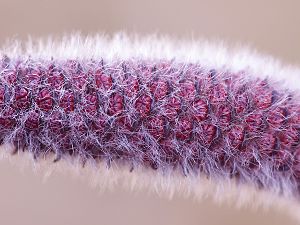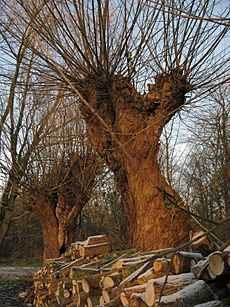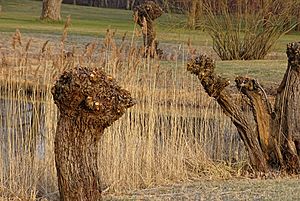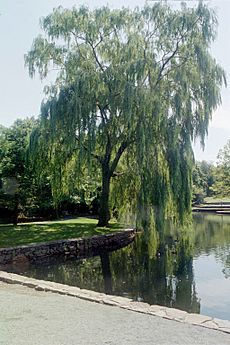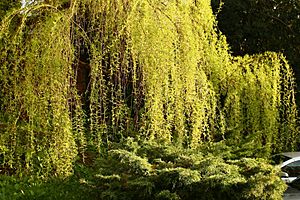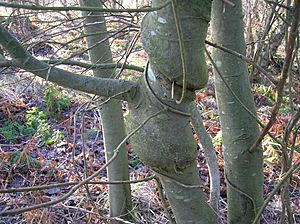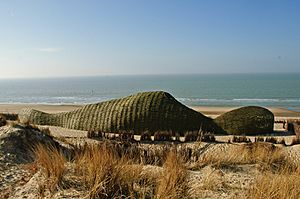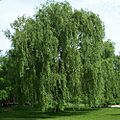Willow facts for kids
Quick facts for kids Willow |
|
|---|---|
 |
|
| Salix alba 'Vitellina-Tristis' Morton Arboretum, Lisle, Illinois |
|
| Scientific classification |
|
| Kingdom: | Plantae |
| Clade: | Tracheophytes |
| Clade: | Angiosperms |
| Clade: | Eudicots |
| Clade: | Rosids |
| Order: | Malpighiales |
| Family: | Salicaceae |
| Tribe: | Saliceae |
| Genus: | Salix L., nom. cons. |
| Type species | |
| Salix alba |
|
| Diversity | |
| About 350 species | |
Willows are a type of tree or shrub that belong to the plant group called Salix. There are about 350 different kinds, or species, of willows. Most willows are deciduous, which means they lose their leaves in the fall. You usually find them growing in wet soil in cool or mild parts of the world.
Some willows are called osiers if they have narrow leaves and grow like shrubs. Other willows with wider leaves are sometimes called sallows. Some willows, especially those in very cold places like the Arctic, are very small. For example, the dwarf willow is usually only about 6 centimeters (2.4 inches) tall, but it can spread out wide along the ground.
Contents
What Are Willows Like?
Willows have a lot of watery sap in their bark. This sap contains a special chemical called salicylic acid. Their wood is usually soft and easy to bend, and their branches are thin. Willow trees also have strong, spreading roots that can grow new plants easily. These roots are known for being very tough and long-lasting.
Willow Leaves
The leaves of willow trees are usually long and thin, but some can be round or oval. They often have jagged or saw-like edges. Most willows lose their leaves in the fall, but a few types, like Salix micans, keep their leathery leaves all year.
Willow trees don't have a bud at the very tip of their branches. Instead, all their buds grow on the sides of the branches. Each bud is covered by a single scale, like a little cap.
The leaves are simple and have veins that look like feathers. They are usually long and narrow, with a rounded base and a pointed tip. The stems of the leaves are short. Willows also have small, leaf-like parts called stipules at the base of their leaves. These can be very noticeable and sometimes stay on the tree for a long time.
Willow leaves come in many shades of green, from yellowish to bluish. Willows are some of the first trees to grow leaves in the spring and some of the last to drop them in the fall. In places like North America, leaves can start growing as early as February if the weather gets warm enough for a few days. In autumn, leaves fall when the days get shorter, usually around October to December, depending on where the willow grows.
Willow Flowers
Most willow trees have separate male and female flowers. This means that male flowers grow on one willow tree, and female flowers grow on a different willow tree. These flowers appear in early spring, often before the leaves, and are grouped together in fuzzy clusters called catkins.
Male flowers don't have petals or sepals. They just have two to ten stamens (the parts that make pollen) and a small gland that produces nectar. These are attached to a fuzzy scale on a drooping catkin. The pollen-making parts are reddish when they are buds but turn orange or purple when they open.
Female flowers also don't have petals or sepals. They have a single ovary (the part that holds the seeds) and a small nectar gland. These are also attached to a scale on a catkin. The ovary has two parts and contains many tiny seeds.
How Willows Are Grouped
The scientific name Salix for willows was first used by Carl Linnaeus in 1753. The most common type of willow, Salix alba (white willow), is the one that the whole Salix group is based on.
The name Salix comes from Latin, and the Romans used it for different kinds of willows. Some people think the word comes from an old Celtic language, where "sal" meant 'near' and "lis" meant 'water', which makes sense because willows often grow near water.
Scientists group willows into smaller categories, but how they do this can change as they learn more. Generally, they divide them into three to five main groups. The oldest willow fossils found are from North America and date back to the early Eocene period, which was millions of years ago.
Types of Willows
There are about 350 different kinds of willow trees and shrubs. They can also easily mix together, or hybridize, creating new types. More than 160 of these mixed types have been named!
Here are some well-known examples:
- Salix aegyptiaca – musk willow
- Salix alba – white willow
- Salix amygdaloides – peachleaf willow
- Salix arctica – Arctic willow
- Salix babylonica – weeping willow (also called Babylon willow or Peking willow)
- Salix bebbiana – beaked willow
- Salix caprea – goat willow or pussy willow
- Salix cinerea – grey willow
- Salix discolor – American pussy willow
- Salix euxina – eastern crack willow
- Salix exigua – sandbar willow
- Salix × fragilis – common crack willow
- Salix glauca – gray willow
- Salix gooddingii - Goodding's black willow
- Salix herbacea – dwarf willow
- Salix humboldtiana - Humbolt's willow (from Central and South America)
- Salix integra
- Salix laevigata – red willow
- Salix lasiolepis – arroyo willow
- Salix microphylla
- Salix mucronata - Safsaf willow (from southern Africa)
- Salix nigra – black willow
- Salix paradoxa
- Salix pierotii – Korean willow
- Salix purpurea – purple willow
- Salix scouleriana – Scouler's willow
- Salix sepulcralis group – hybrid willows
- Salix tetrasperma – Indian willow
- Salix triandra – almond willow
- Salix viminalis – common osier
Willow Life in Nature
Willows can grow well even in shady places, but they usually don't live as long as some other trees. They need things like floods or fires to help them compete with other plants. Their seeds are tiny, light, and carried by wind and water, but they only stay alive for a few days. The seeds need warm, wet conditions to start growing. Willows can also grow new plants from stumps or broken branches.
Willows produce a good amount of nectar, which bees use to make honey. They are especially important because they provide pollen for bees early in the spring. Many animals eat willow leaves or find shelter among the trees. Beavers even use willows to build their dams! The young forms (larvae) of some butterflies, like the mourning cloak butterfly, eat willow leaves. Ants, like wood ants, often visit willows that have aphids (tiny insects) to collect the sweet liquid called honeydew that aphids produce. Wasps sometimes do this too.
Willow Pests and Diseases
Willows are home to over a hundred types of aphids. These tiny insects form large groups, especially on the underside of leaves, to feed on the plant's juices. The willow lace bug is another insect that feeds on willows in North America. There's also a type of growth called a gall (like a small bump) that can be found on willows, caused by an insect called Rhabdophaga rosaria.
A type of fungus called rust can also damage willow leaves, covering them with orange spots.
Protecting Willows
In some places, like Australia, certain willow species were planted to help stop soil from washing away near rivers. However, these willows are now seen as harmful invasive weeds because they spread very quickly and take over large areas. Many groups are now working to remove these willows and plant native trees instead.
Growing Willows
Most willows are very easy to grow from cuttings. If you take a piece of a willow branch and put it in the ground, it will often grow roots and become a new tree! This is why broken willow branches can easily start growing new trees where they fall. A famous story tells how the poet Alexander Pope planted a willow twig, and it's said that all weeping willows in England came from that one twig.
Willows are grown all over the world for many reasons. They are used in hedges and for making gardens look nice.
Willow Hybrids and Special Types
Willows can easily mix with each other, creating many hybrids (new types that are a mix of two different kinds). This happens both naturally and when people grow them. A well-known example is the weeping willow (Salix × sepulcralis), which is a mix of the Peking willow from China and the white willow from Europe.
Over many years, people have developed and named many special types of willows called cultivars. These are chosen because they have good qualities for different uses, like being pretty in a garden or growing fast. Many willows have even won awards for being great garden plants. Lately, willows have become important for making bioenergy (energy from plants) because they grow so quickly.
How Willows Are Used
Long ago, some Native American people used willow bark to make strong string for things like harpoon lines. They also used willow wood to start fires by rubbing pieces together. Willow shoots were used to weave baskets, and branches and stems were used to build things like fishing traps.
Willow in Medicine
People have known about the medicinal uses of willow leaves and bark for a very long time. Ancient texts from places like Assyria, Sumer, and Egypt mention them. The Greek doctor Hippocrates wrote about willow's healing properties in the 400s BC.
It's hard to know exactly how ancient people used willow, but some old writings suggest it was used for different health issues. For example, the ancient Egyptian Ebers Papyrus mentions willow in remedies for making muscles flexible or for general weakness.
In 1763, an English clergyman named Edward Stone noticed that willow bark tasted bitter, like another plant (cinchona) used to treat fevers. He tried willow bark on people with fevers and thought it worked well. However, doctors at the time didn't widely adopt his remedy.
Later, in 1876, a Scottish doctor named Thomas John MacLagan found that a substance from willow, called salicin, helped treat a condition called acute rheumatism. Around the same time, German scientists were working with a similar chemical.
The famous painkiller Aspirin was created in 1897 by Felix Hoffmann at Bayer. He made acetylsalicylic acid, which was found to relieve pain. While aspirin is related to the chemicals found in willow, it was a new chemical created in a lab, not directly from the willow tree itself.
In modern times, some people still use willow bark for herbal remedies. Some believe it helps with headaches and other pains, linking it to the development of aspirin. However, current research suggests that willow extract might only have a very mild pain-relieving effect, and this might be due to other plant compounds, not just salicylic acid.
Making Things from Willows

Willows have been used by humans for a very long time. A fishing net made from willow was found that dates back to 8300 BC!
Simple crafts like baskets, fish traps, and fences were made from willow branches, especially thin, flexible ones called osiers or withies. The framework of some traditional Welsh boats, called coracles, is also made from willow.
Thin willow rods can be woven into wicker items. Willow is good for weaving because it bends easily without breaking.
Willow wood is used to make many things, including boxes, brooms, cricket bats, furniture, dolls, flutes, poles, toys, and tool handles. The wood can also be used to make tannin (a substance used in leather making), fiber, paper, and rope.
Willow wood is also used in making musical instruments like double basses.
Willow in Gardens
A liquid made from willow bark is used in gardens in Europe to help control plant diseases like scab and powdery mildew on grapes, apples, and peaches.
Willow Problems
Willow roots spread out very far and aggressively search for water. Because of this, they can cause problems if planted near homes. Their roots are known for clogging French drains, drainage pipes, and septic systems, especially older ones made of clay or concrete. Newer plastic pipes are less likely to leak, so they have fewer problems with willow roots.
Other Uses of Willows
- Warfare: During World War II, willows were very important for Britain. Everything dropped by parachutes was put in baskets made of willow. These baskets were light, strong, and could be made in any shape. They also bounced when they landed, which protected the items inside.
- Art: Willow wood is used to make charcoal for drawing. Live willow branches can also be woven into living sculptures, like domes and tunnels. Artists use willow stems to create baskets and sculptures of animals.
- Energy: Because willows grow so fast, scientists are looking into using them to produce biomass or biofuel (energy from plants). Programs in different countries are exploring this, like the Willow Biomass Project in the US. Willows can also be grown to make charcoal.
- Environment: Willows are being studied for use in cleaning wastewater and restoring damaged land. They are also used to stabilize riverbanks, prevent soil erosion, create windbreaks, and provide homes for wildlife. Their strong, spreading roots help protect banks from water.
- Food: In the past, poor people sometimes ate cooked willow catkins. The inner bark, young leaves, and underground shoots of willows can also be eaten raw or cooked.
Willows in Culture
The willow is one of the four special plants used in the Jewish festival of Sukkot, or the Feast of Tabernacles. Willow branches are also used in synagogue services on the seventh day of Sukkot.
In Buddhism, a willow branch is an important symbol for Kwan Yin, who is seen as the bodhisattva (a person who helps others reach enlightenment) of compassion.
Some Orthodox churches use willow branches instead of palm branches during their ceremonies on Palm Sunday.
In China, some people carry willow branches on the day of their Tomb Sweeping or Qingming Festival. They also put willow branches on gates or front doors because they believe it helps keep away evil spirits that wander on Qingming. In traditional pictures of the Goddess of Mercy Guanyin, she is often shown with a willow branch in a vase of water. She uses this water and branch to chase away demons. Some Taoist witches also use small carvings made from willow wood to talk with spirits of the dead. The willow is a very popular subject in art, especially in ink paintings from China and Japan.
In Japanese stories, the willow is linked to ghosts. People often believe that a ghost will appear where a willow tree grows. Willows also appear in many other folk tales and myths.
In English folklore, some people believe willow trees can be a bit scary, even able to pull up their roots and follow travelers! One of the Seven Hills of Rome, the Viminal Hill, gets its name from the Latin word for osier (a type of willow).
Hans Christian Andersen wrote a story called "Under the Willow Tree" (1853) where children talk to a tree they call "willow-father."
"Green Willow" is a Japanese ghost story about a young samurai who falls in love with a woman named Green Willow, who has a special connection to a willow tree. "The Willow Wife" is another similar tale. "Wisdom of the Willow Tree" is a story from the Osage Nation where a young man asks a willow tree for answers, calling the tree 'Grandfather'.
Images for kids
-
Pollard willow and woodpile in the Bourgoyen-Ossemeersen, Ghent, Belgium
-
Berlin Britzer Garten pollarded willow tree in the spring of March 2018
-
Cricket bats are traditionally made from willow wood.
See also
 In Spanish: Sauces para niños
In Spanish: Sauces para niños
- Aravah, the Hebrew name of the willow, for its ritual use during the Jewish Feast of Tabernacles
- Withy
- Pollarding, technique of severe pruning or knotting of trees
- Sail, Ogham letter meaning "willow"
- Willow water, using the rooting hormone indolebutyric acid from willow branches to stimulate root growth in new cuttings



